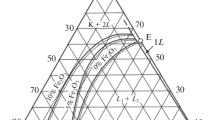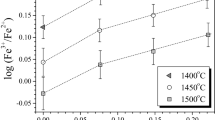Abstract
We have developed a new technique for the experimental determination of the activities of oxide components in melts and minerals using the equilibrium between Pd alloy, oxygen, and the oxide component in the sample of interest. If a melt or mineral sample is equilibrated with Pd metal at fixed P, T, and f O 2, a small amount of each constituent oxide will reduce to metal and dissolve into the Pd, forming an alloy. Due to the extraordinary stability of dilute alloys of Pd with Mg, Al, and Si, these metals dissolve into the Pd in amounts easily measured with the electron microprobe at f O 2 s that can be achieved with conventional gas-mixing techniques. We determined the activity-composition relations for Pd−Mg, −Al, and −Si alloys by equilibrating Pd at fixed f O 2and T with periclase, corundum, and cristobalite (a oxide≡1). Because Mg, Al, and Si have constant activity coefficients in Pd at low concentrations, the activity of the oxide of each metal is a simple function of the ratio of the concentration of the metal in Pd in equilibrium with the sample to that in Pd in equilibrium with the pure oxide. Therefore, if Pd plus a melt or mineral and Pd plus pure oxide standards are equilibrated simultaneously at fixed T and f O 2, the precision of the analytical technique is the major limitation on the determination of oxide activities. We used Pd-oxide equilibration to explore activities in silicate melts analogous to Type B Ca−Al-rich inclusions (CAIs) from carbonaceous chondrites; the measured activities deviate systematically from model valves but agree to within 1–30%. The activities imply that Type B CAIs did not condense as liquids from a gas of solar composition, and that only very aluminous compositions are potential liquid condensates from the solar nebula. We also used Pd-oxide equilibration to determine the free energy of formation from the oxides, ΔG /O f , of the spinel end-member MgAl2O4 at 1150 to 1400°C to a precision of 2–19% (1∂). Because the technique reflects equilibration at high temperature, the ΔG /O f s accurately represent the mineral with equilibrium Mg−Al disorder at temperature, a feature not true of drop calorimetric results because of partial reordering during quenching. Our results indicate more negative ΔG Emphasis>/O f and hence higher entropy of formation, ΔS Emphasis>/O f , than given in most compilations of thermodynamic data for spinel.
Similar content being viewed by others
References
Abraham KP, Davies MW, Richardson FD (1960) Activities of manganese oxide in silicate melts. J Iron Steel Inst London 196: 82–89
Alper AM, McNally RN, Ribbe PH, Doman RC (1962) The system MgO−MgAl2O4. J Am Ceram Soc 45: 263–268
Armstrong JT (1988) Quantitative analysis of silicate and oxide minerals: comparison of Monte Carlo, ZAF, and ϕ(p z) procedures. In: Newbury DE (ed) Microbeam analysis 1988. San Francisco Press, San Francisco, pp 239–246
Beckett JR, Spivack AJ, Hutcheon ID, Wasserburg GJ, Stolper EM (1990) Crystal chemical effects on the partitioning of trace elements between mineral and melt: an experimental study of melilite with applications to refractory inclusions from carbonaceous chondrites. Geochim Cosmochim Acta 54: 1755–1774
Berman RG (1983) A thermodynamic model for multicomponent melts with application to the system CaO−MgO−Al2O3−SiO2 (unpublished). PhD thesis, Univ British Columbia
Berman RG (1988) Internally-consistent thermodynamic data for minerals in the system Na2O−K2O−CaO−FeO−Fe2O3−Al2O3−SiO2−TiO2−H2O−CO2. J Petrol 29: 445–522
Blander M, Fuchs LM (1975) Calcium-aluminum-rich inclusions in the Allende meteorite: evidence for a liquid origin. Geochim Cosmochim Acta 39: 1605–1619
Brearley AJ, Casanova I, Miller ML, Keil K (1991) Mineralogy and possible origin of an unusual Cr-rich inclusion in the Los Martinez (L6) chondrite. Meteoritics 26: 287–300
Brodowsky H and Husemann H (1966) Wasserstoff in Palladiumlegierungen. Ber Bunsenges Phys Chem 70: 626–630
Brodowsky HA, Schaller HJ (1969) Thermodynamics of nonstoichiometric interstitial alloys. I. Boron in palladium. Trans Metall Soc AIME 245: 1015–1020
Brodowsky H, Oei YS, Schaller HJ (1980) Thermodynamische Eigenschaften von Palladium-Cadmium-Legierungen. Z Metallk 71: 593–598
Chamberlin LA (1994) Pd-oxide equilibration: a new experimental method for the direct determination of the activities of oxide components in melts and minerals (unpublished). PhD thesis, Caltech
Chase MW Jr, Davies CA, Downey JR Jr, Frurip DJ, McDonald RA, Syverud AN (1985) The JANAF thermochemical tables, 3rd edn. J Phys Chem Ref Data 14 Suppl 1
Cima M, Brewer L (1988) The generalized Lewis acid-base titration of palladium and niobium. Metall Trans B 19: 893–917
Dudson PJ, Fraser DG (1980) Nickel oxide activities in silicate melts in the system CaO−MgO−Al2O3−NiO2−NiO. Prog Exp Petrol 5: 247–251
Fegley B, Palme H (1985) Evidence for oxidizing conditions in the solar nebula from Mo and W depletions in refractory inclusions in carbonaceous chondrites. Earth Planet Sci Lett 72: 311–326
Frölich H (1936) Elektronentheorie der Metalle. Julius Springer, Berlin
Fulton JC, Chipman J (1954) Slag-metal-graphite reactions and the activity of silica in lime-alumina-silica slags. J Met 200: 1136–1146
Ghiorso MS, Carmichael ISE, Sack RO (1983) The Gibbs free energy of mixing of natural silicate liquids; an expanded regular solution approximation for the calculation of magmatic intensive variables. Contrib Mineral Petrol 84: 107–145
Grimsey EJ (1988) the effect of temperature on nickel solubility in silica saturated fayalite slags from 1523 to 1623 K. Metall Trans B 19B: 243–247
Grove TL (1988) Use of Fe−Pt alloys to climinate iron loss problom in 1 atmosphere gas mixing experiments: Theoretical and practical considerations. Contrib Mineral Petrol 78: 298–304
Hallstedt B (1992) Thermodynamic assessment of the system MgO−Al2O3. J Am Ceram Soc 75: 1497–1507
Heine V (1969) Electronic structure of metals. In: Ziman JM (ed) The physics of metals. Cambridge University Press, Cambridge, pp 1–61
Helgeson HC, Delany JM, Nesbitt HW, Bird DK (1978) Summary and critique of the thermodynamic properties of rock-forming minerals. Am J Sci 278A: 1–229
Holland TBJ, Powell R (1990) An enlarged and updated internally consistent thermodynamic dataset with uncertainties and correlations: the system K2O−Na2O−CaO−MgO−MnO−FeO−Fe2O3−Al2O3−TiO2−SiO2−C−H2−O2. J Metamorphic Geol 8: 89–124
Kleykamp H, Kang S-G (1991) The constitution of the uranium-palladium and uranium-rhodium-palladium systems. Z Metallk 82: 544–552
Lange RA, De Yoreo JJ, Navrotsky A (1991) Scanning calorimetric measurement of heat capacity during incongruent melting of diopside. Am Mineral 76: 904–912
Langenberg FC, Chipman J (1959) Activity of silica in CaO−Al2O3−SiO2 slags at 1600° and 1700°C. Trans Metall Soc AIME 215: 958–962
Langenberg FC, Kaplan H, Chipman J (1958) The activity of silica in lime-alumina-silica slags at 1600°C. In: Elliot JF (ed) Physical chemistry of steelmaking. John Wiley, New York, pp 65–67
Lejus A (1964) Sur la formation à haute température de spinelles nonstœichiométriques et de phase dérivées dans plusieurs systèmes d'oxydes à base d'alumine et dans le système aluminenitrure d'aluminium. Rev Hautes Tempér Réfract 1: 53–95
Mattioli GS, Wood BJ, Carmichael ISE (1987) Ternary-spinel volumes in the system MgAl2O4−Fe3O4−γFe8/3O4: implications for the effect of P on intrinsic f O 2 measurements of mantlexenolith spinels. Am Mineral 72: 468–480
McAlister AJ (1986) The Al−Pd (aluminum-palladium) system. Bull Alloy Phase Diag 7: 368–374
Millard RL, Peterson RC, Hunter BK (1992) Temperature dependence of cation disorder in MgAl2O4 spinel using 27Al and 17O magic-angle spinning nuclear magnetic resonance spectroscopy. Am Mineral 77: 44–52
Moffatt WG (1982) Handbook of binary phase diagrams. General Electric Company, Schnectady, New York
Navrotsky A, Wechsler BA, Geisinger K, Seifert F (1986) Thermochemistry of MgAl2O4−Al8/3O4 defect spinels. J Am Ceram Soc 69: 418–422
Navrotsky A, Ziegler D, Oestrike R, Maniar P (1989) Calorimetry of silicate melts at 1773 K: measurement of enthalpies of fusion and of mixing in the systems diopside-anorthite-albite and anorthite-forsterite. Contrib Mineral Petrol 101: 122–130
Nayeb-Hashemi AA, Clark JB (1985) The Mg−Pd (magnesium-palladium) system. Bull Alloy Phase Diag 6: 164–167
Ozturk B, Frueban RJ (1987) Activity of silica in calcium-aluminate based slags. Metall Trans B 18B: 746–749
Peterson RC, Lager GA, Hitterman R (1991) A time-of-flight neutron diffraction study of MgAl2O4 at temperatures up to 1273 K. Am Mineral 76: 1455–1458
Rein RH, Chipman J (1963) The distribution of silicon between Fe−Si−C alloys and SiO2−CaO−MgO−Al2O3 slags. Trans Metall Soc AIME 227: 1193–1203
Rein RH, Chipman J (1965) Activities in the liquid solution SiO2−CaO−MgO−Al2O3 at 1600°C. Trans Metall Soc AIME 233: 415–425
Robie RA, Hemingway BR, Fisher JR (1978) Thermodynamic properties of minerals and related substances at 298.15K and 1 bar (105 Pascals) pressure and at higher temperatures. USGeol Surv Bull 1452: 1–456
Sahoo P, Reddy RG (1984) Activity coefficient of nickel oxide in FeO−NiO−FeO1.5−AlO1.5−SiO2 at 1573K. In: Fine HA, Gaskell DR (eds) Second International Symposium on Metallurgical Slags and Fluxes. Metallurgical Society of AIME. Warrendale, Pennsylyania, pp 533–545
Sato M (1971) Electrochemical measurements and control of oxygen fugacity and other gaseous species with solid electrolyte sensors. In: Ulmer GC (ed) Research techniques for high pressure and high temperature. Springer, New York Berlin Heidelberg, pp 43–100
Schaller HJ (1976) Aktivitätskoeffizienten von Zirkon in Palladium und Platin. Ber Bunsenges Phys Chem 80: 999–1002
Schaller HJ (1978) Der Einfluß der Lage der Fermi-Energie auf das Mischungsverhalten von Palladium/Aluminium-Legierungen. Ber Bunsenges Phys Chem 82: 365–371
Schaller HJ (1979) Über die extrem hohe thermodynamische Stabilität von Pd−Th-Legierungen. Z Naturforsch 34a: 464–468
Schaller HJ, Brodowsky H (1978a) Thermodynamische Eigenschaften von Palladium-Zinn-Legierungen. Z Metallk 69: 87–93
Schaller HJ, Brodowsky H (1978 b) Thermodynamic properties of palladium-indium alloys. Ber Bunsenges Phys chem 82: 773–778
Schaller HJ, Craig RS, Wallace WE (1972) Magnetic and crystallographic characteristics of solid solutions of Gd in Pd and Pd−Ag alloys. J Solid State Chem 5: 338–341
Sharma RA, Richardson FD (1965) Activities of manganese oxide, sulfide capacities, and activity coefficients in aluminate and silicate melts. Trans Metall Soc AIME 233: 1586–1592
Snyder DA, Carmichael ISE (1992) Olivine-liquid equilibria and the chemical activities of FeO, NiO, Fe2O3, and MgO in natural basic melts. Geochim Cosmochim Acta 56: 303–318
Stolper EM (1982) Crystallization sequences of Ca, Al-rich inclusions from Allende: an experimental study. Geochim Cosmochim Acta 46: 2159–2180
Tsukihashi F, Werme A, Matsumoto F, Kasahara A, Yukinobu M, Hyodo T, Shiomi S, Sano N (1984) Thermodynamics of the soda slag system for hot metal treatment. In: Fine HA, Gaskell DR (eds) Second International Symposium on Metallurgical Slags and Fluxes. American Institute of Mining, Metallurgical, and Petroleum Engineers Inc, New York, pp 89–106
Wagner RD, Larimer JW (1978) Condensation and stability of oxide/silicate melts. Meteoritics 13: 651
Wark DA (1987) Plagioclase-rich inclusions in carbonaceous meteorites: liquid condensates? Geochim Cosmochim Acta 51: 221–242
Weill DF, Hon R, Navrotsky A (1980) The igneous system CaMgSi2O6−CaAl2SiO8−NaAlSi3O6: variations on a classic theme by Bowen. In: Hargraves RB (ed) Physics of magmatic processes. Princeton University Press, Princeton, New Jersey, pp 49–92
Wood BJ, Kirkpatrick RJ, Montez B (1986) Order-disorder phenomena in MgAl2O4 spinel. Am Mineral 71: 999–1006
Wood JA, Morfill GE (1988) A review of solar nebula models. In: Kerridge JF and Matthews MS (eds) Meteorites and the early solar system. University of Arizona Press, Tucson, pp 329–347
Author information
Authors and Affiliations
Additional information
Division of Geological and Planetary Sciences Contribution #5278
Rights and permissions
About this article
Cite this article
Chamberlin, L., Beckett, J.R. & Stolper, E. Pd-oxide equilibration: a new experimental method for the direct determination of oxide activities in melts and minerals. Contr. Mineral. and Petrol. 116, 169–181 (1994). https://doi.org/10.1007/BF00310698
Received:
Accepted:
Issue Date:
DOI: https://doi.org/10.1007/BF00310698




